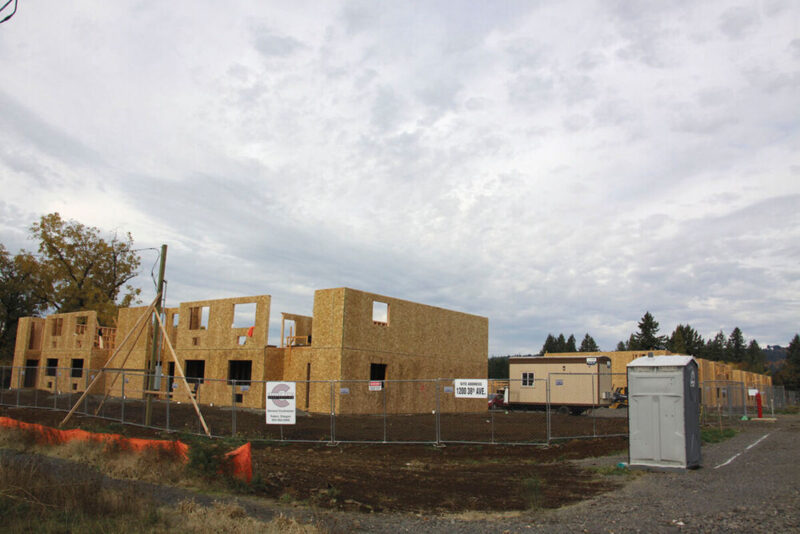Benny Westcott
When discussing construction in Sweet Home, words like “growth” and “demand” come up often.
According to the Community Economic Development Department Report for Dec. 2021, the city issued 350 building permits in 2021, a 27.7% increase from 274 in 2020. That’s a 17.5% jump from the annual average of permits issued from 2016-2020.
“It’s reflecting the market,” Community and Economic Development Director Blair Larsen said. “There is a huge demand for residential properties. People were waiting around to see if building made sense for them, and the demand has pushed them over the edge. People want to build something if there’s a market for it.”
This demand came despite much-discussed material shortages and raised prices.
“Obviously, we haven’t seen a decrease in activity because of the cost of materials,” Larsen said. “It’s hard to say when or if materials costs will have a dampening effect on building growth. So far, they haven’t.”
Some people anticipated that the pandemic would have negative effects on the housing market. But, according to Larsen, that hasn’t been the case.
“At the very beginning, people assumed it would be a major downturn,” he said. “But people failed to realize the nature of the pandemic, that people who were working from home would want to be in a better home. It was pretty clear by the end of 2020 that the cost of housing was already rising to meet that demand. Housing costs are an indicator of demand in the market. People are going to rush in to fill that demand as much as they can.”
Larsen doesn’t predict an end to the rise in housing prices anytime soon.
“At some point prices may get to a point where people can’t handle it anymore, and the pace may slow, but I don’t really see it stopping this year,” he said.
He noted that single-family homes built in 2021 were “mostly lots here and there that were going in, rather than being concentrated in one place. Most of the recent growth has been in the eastern and southern portions of Sweet Home, and that will probably continue, because that’s where the vacant land is.”
The city also saw some not-so-familiar construction last year: apartments. The Cascade Meadows Apartments at 2500 Long St., which consists of four buildings and 48 units, opened last summer. Another four-building, 40-unit spot is going up around Long Street and 38th Avenue, behind City Hall.
“We haven’t had a new apartment complex with more than four units in, like, 50 years,” Larsen said. “It certainly is a milestone for Sweet Home, and I think it really shows the demand for housing. With the constraints we have on housing in Oregon, people are looking at multi-family units as a way to meet demand and maximize the value they get out of a property. Builders have bigger returns on investment in this current market than they otherwise would.”
“A confluence of factors led to it being the right time for additional large apartments to go into Sweet Home,” he continued. “There are a number of residents that need a place to live. They can’t afford a home but can afford an apartment.”
He expects “more of the same” in the future.
“It’s great to see the demand, great to see there’s plenty of people who want to come to Sweet Home, and plenty who want to improve their living situation,” he said.
Construction will likely continue this year, with plans underway for more housing.
A “Phase 3” of building is planned in the Duck Hollow neighborhood around Long Street and 41st Avenue. Some “30 or 40” more homes are set to be added to an expanded Lily Street, Larsen said.
Although a contractor’s intent to expand a Main Street/45th Avenue neighborhood by 46 lots won’t reach full fruition, 32 homes are still planned. Additionally, a subdivision of 25 is slated for an expanded western end of Foothills Drive. That project was approved, but construction has yet to begin.
The continued construction indicates, and perhaps is a response to, population growth. The 2020 U.S. Census recorded 9,828 people in the city, but that count came “before the apartments came online,” Larsen said. “We’re clearly over the 10,000 threshold at this point. That gets noticed by the business community. There are a lot of corporations and businesses that make decisions strictly on demographics. More services are coming because growth is here.”
And while not everyone may be a fan of an increasing population, Larsen suggested that growth is here to stay.
“There are plenty of people who are concerned about growth and want things to stay the same,” he said. “I encourage them to be involved in the planning commission and shape growth in the way we want it to happen, because growth is going to happen no matter what.”




